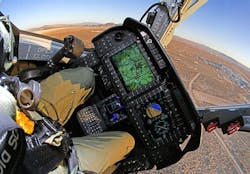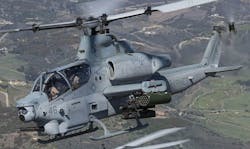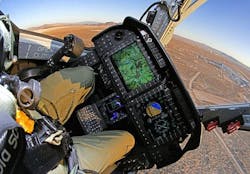Lockheed Martin to provide electro-optical targeting systems for U.S. Marine Corps attack helicopters
Officials of the Naval Surface Warfare Center in Crane, Ind., announced an $11.8 million order on Friday to the Lockheed Martin Missiles and Fire Control segment in Orlando, Fla., for five AN/AAQ-30 target sight systems (TSS).
The TSS equipment for Marine Corps Viper helicopter gunships is part of the Marine Corps H-1 upgrades program for the remanufacture of legacy aircraft with state-of-the-art designs to convert the Marine Corps' existing fleet of AH-1W SuperCobra attack helicopters to the AH-1Z Viper, Navy officials say.
The Lockheed Martin AN/AAQ-30 TSS provides target identification and tracking, passive targeting for integrated weapons -- including Hellfire missiles -- and a laser designation for laser-guided weapons. TSS provides can identify and laser-designate targets at the maximum ranges of Viper helicopter weapons.
The AN/AAQ-30 targeting system is a large-aperture midwave forward-looking infrared (FLIR) sensor, color TV, laser designator and rangefinder (with eyesafe mode), and on-gimbal inertial measurement unit integrated into a stabilized turret on the nose of the helicopter.
Related: Navy asks Bell to build 29 new AH-1Z Viper attack helicopters and avionics for Marine Corps
The AN/AAQ-30 has an 8.55-inch aperture, midwave staring FLIR with four fields-of-view for image resolution and long-range performance. Its gimbal is stabilized to less than 15 microradians.
The sensor also has advanced image processing for sharp imagery; algorithms for enhanced image recognition and identification; high magnification; continuous zoom; and color TV with field-of-view matched to the FLIR.
The AN/AAQ-30 also has a cooled 640-by-512-pixel indium antimonide detector, as well as a modular architecture for future growth, Lockheed Martin officials say.
On this order Lockheed Martin will do the work in Orlando and Ocala, Fla., and should be finished by January 2022. For more information contact Lockheed Martin Missiles and Fire Control online at www.lockheedmartin.com, or the Naval Surface Warfare Center-Crane at www.navsea.navy.mil/Home/Warfare-Centers/NSWC-Crane.
Ready to make a purchase? Search the Military & Aerospace Electronics Buyer's Guide for companies, new products, press releases, and videos


